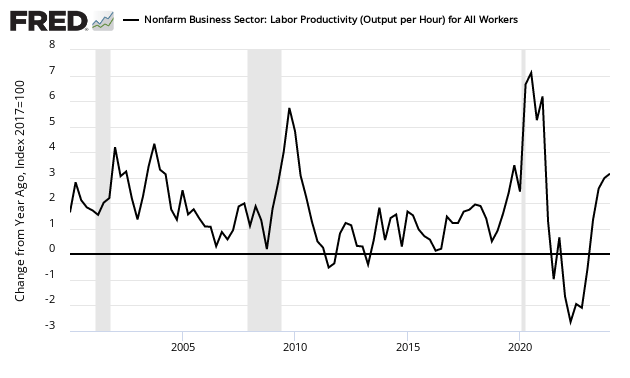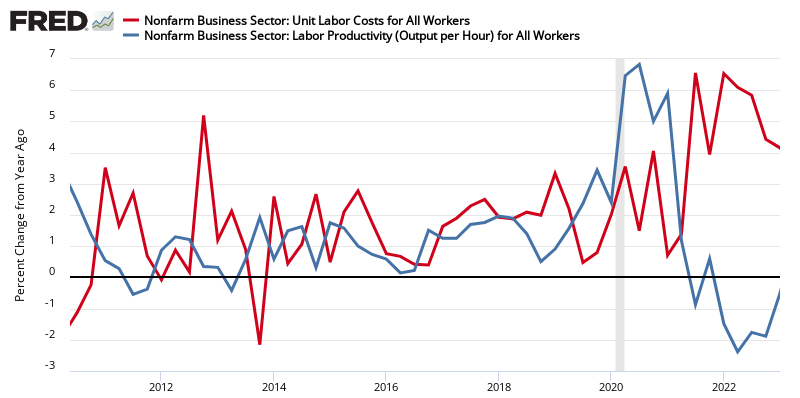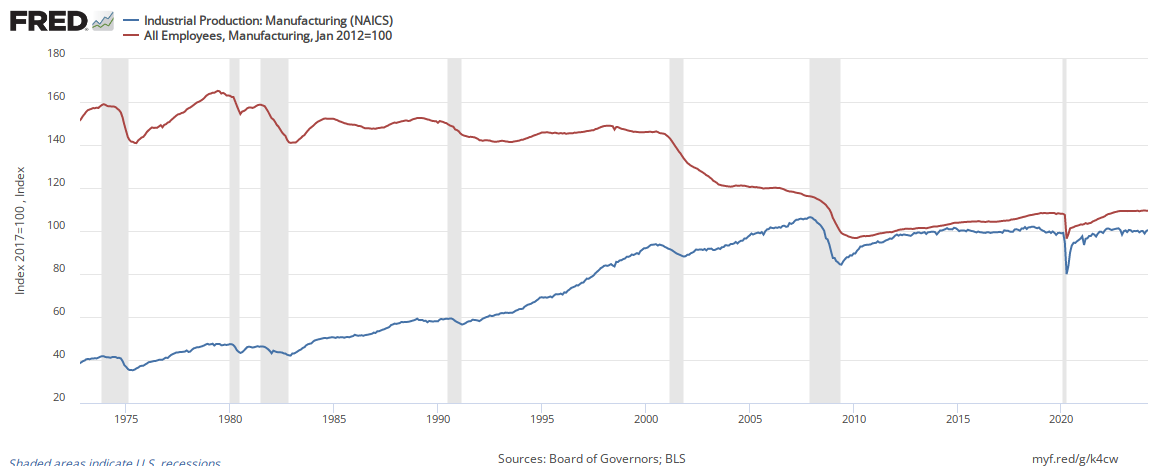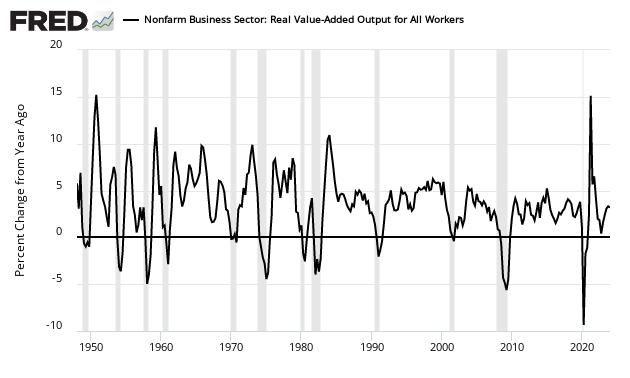1Q2020 Final Headline Productivity Hit By The Coronavirus
A simple summary of the headlines for this release is that labor costs are growing significantly faster than productivity on a quarter-over-quarter and year-over-year basis - and the pandemic has caused productivity to crater.

Analyst Opinion of Productivity and Costs
The overall view this quarter is that productivity is up 0.7 % from the same quarter one year ago while unit costs are up 1.9 %.
Please note my productivity analysis at the end of this post which is at odds with the headline view. Doing a productivity analysis during a major recession is a waste of time.
Note the following from the BLS:
BLS quarterly estimates of labor productivity combine output data with hours worked data based primarily on the Current Employment Statistics (CES) survey. The reference period for the CES largely predated many of the COVID-19-related job losses that occurred in the latter part of March. To capture these job losses, adjustments were made to March employment, based on the Department of Labor's Employment and Training Administration weekly reports of the number of initial claims for unemployment insurance benefits. Hours and related measures—including labor productivity—for the first quarter of 2020 reflect these adjustments.
The market was expecting from Econoday:
(Click on image to enlarge)

Annualized snippets of monthly or quarterly data distort what is going on. In reality, productivity growth is near post-Great Recession highs using a year-over-year analysis.
(Click on image to enlarge)

Please note that the following graphs are for a sub-group of the report nonfarm > business.
Seasonally Adjusted Year-over-Year Change in Output of Business Sector
(Click on image to enlarge)

Seasonally Adjusted Year-over-Year Change of Output per Hour for the Business Sector
(Click on image to enlarge)

All this is happening while business sector unit labor costs are growing.
Seasonally Adjusted Year-over-Year Rate of Change of Unit Labor Costs
(Click on image to enlarge)

The headlines from the press release:
Nonfarm business sector labor productivity decreased 0.9 percent in the first quarter of 2020, the U.S. Bureau of Labor Statistics reported today, as output decreased 6.5 percent and hours worked decreased 5.6 percent. (All quarterly percent changes in this release are seasonally adjusted annual rates.) From the first quarter of 2019 to the first quarter of 2020, productivity increased 0.7 percent, reflecting no change in output and a 0.7-percent decrease in hours worked.
Preliminary Chart for 1Q2020
(Click on image to enlarge)

Final Chart for 1Q2020
(Click on image to enlarge)

My view of Productivity
My view of productivity is very different from the headline view. Productivity calculations are complicated - far too complicated for economists to come to a conclusion satisfactory to this simple Industrial Engineer:
Generally speaking, productivity is, in industrial engineering, defined as the relation of output (i.e. produced goods) to input (i.e. consumed resources) in the manufacturing transformation process.
Productivity assessments, even within a single company, are very complicated. When one goes beyond the individual company, they are impossible to accurately forecast when discussing an entire sector or economy. Industrial engineers do not use costs as a component to determine productivity. Industrial Engineers count processes and manhours - and are able to isolate improvements as elements change. So to generalize about sectors, economists have to make too many assumptions which not only make the calculations inaccurate - but their productivity conclusions jump around like a Mexican Jumping Bean.
Productivity, according to the BLS methodology, is calculated by dividing an index of real output by an index of hours worked by all persons. The hours worked come from the BLS Current Employment Statistics (CES) but the basis for "real output" comes from GDP. Per the BLS:
Business sector output is a chain-type, current-weighted index constructed after excluding from gross domestic product (GDP) the following outputs: general government, nonprofit institutions, and private households (including owner-occupied housing).
Those that follow my work know my disdain for how productivity is calculated by economists. The problem is that there is no way to do a realistic productivity analysis for the entire economy which would be accurate enough to be acceptable to an industrial engineer. The current methodology uses a monetary approach:
-
profit/loss and overhead has no place in a productivity analysis yet it approaches impossible to remove
-
adjusts for inflation but it would only take a small error in determining the inflation rate to significantly skew the calculation
-
it is impossible to measure productivity change for a startup or a new business
A rough and dirty calculation using monetary data available - the "decline" of productivity can be confirmed if one looked at GDP growth per employee after removing government transfer payments from GDP. (see red line in the graph below) - although productivity did improve in 4Q2019:
(Click on image to enlarge)

If the red line in the above graph suggests there is an overall productivity growth decline - For this to be true it suggests:
- too many employees have been employed for the tasks at hand; and/or
- companies and employees have decided not to use some of their existing labor-saving tools; and/or
- a natural disaster occurred; and/or
- companies have decided not to embrace any new labor-saving technologies and/or
- more people are employed in activities not producing output measured by GDP
- there is a pandemic which killed the economy
Slowing growth for productivity seems to defy logic in times of economic expansion.
A Better View Of Productivity [productivity analysis in a pandemic is useless]
There are some rough tools that will get one into the ballpark of productivity improvement. These are monetary-based views, and likely are correct only in trends (but not in calculating an exact productivity change).
The following graphs on manufacturing, investment, retail trade, and health care are comparing inflation-adjusted growth of that sector to employment growth in that sector - as well as for the economy overall.
Economy Overall
In the case of the economy overall, for the last two years - it appears output (blue line) is now growing faster than employment.
(Click on image to enlarge)

The problem with this analysis is that it is a gross generalization - but it does estimate that we are looking for a positive productivity increase in the last year.
Manufacturing
In the case of manufacturing, output (blue line) is now growing slower than employment.
(Click on image to enlarge)

It should come as no surprise that manufacturing's productivity is contracting.
Construction
Construction is now signaling negative productivity growth.
(Click on image to enlarge)

Services
The only significant productivity growth I can find is in the services sector [although see what the pandemic is doing to this sector]
Beginning with the retail sector, the obvious gain in productivity is seen throughout the graph below and continues today.
(Click on image to enlarge)

There also is an improvement in the health care sector.
(Click on image to enlarge)

Overall Conclusion On Productivity
If you want to be entertained with a diatribe on productivity - Yves Smith carved up this subject well looking at it from an entirely different angle. In economics and life, a little knowledge [on a subject] is a dangerous thing.
This proverb 'A Little Knowledge Is A Dangerous Thing' means a person is sharing his views with others and doesn't have enough knowledge of a particular subject, especially medical, religion, or education field, it can lead to dangerous situations. People with limited experience can often mislead people. Innocent people or people with a lack of information may easily believe the person pretending to know everything because most of the time, they are very convincing. A person with a little information and knowledge can also become a cause of suffering and even death due to their overconfidence.
The problem really is that economists seem to only understand money flows - and they use money to measure productivity. Productivity is an extremely nuanced calculation which is never totally accurate as there are shifting technology and/or methods. The core of industrial engineering productivity is a measure of labor hours for a specific task Vs. the output of those labor hours - and that detailed data is not available to anyone outside of a company.
The economist's methodology of measuring productivity overstates productivity when outsourcing is increasing and understates productivity when outsourced production is returned.
Caveats Relating to Productivity
Productivity is determined using monetary criteria and does not recognize outsourced man-hours - in other words, if a business cuts half of its workforce by outsourcing a sub-component or sub-service, this would be a 50% productivity improvement.
These productivity measures describe the relationship between real output and the labor time involved in its production. They show the changes from period to period in the amount of goods and services produced per hour. Although these measures relate output to hours at work of all persons engaged in a sector, they do not measure the specific contribution of labor, capital, or any other factor of production. Rather, they reflect the joint effects of many influences, including changes in technology; capital investment; level of output; utilization of capacity, energy, and materials; the organization of production; managerial skill; and the characteristics and effort of the work force.
Econintersect believes a better measure (if you must use monetary tools to track productivity) would be competitiveness.
Looking at productivity/output long term - output fall below 0% year-over-year change is a good sign that a recession is underway. Another way to look at it - if productivity rate of gain is falling, this could be an indicator a recession is coming.
(Click on image to enlarge)

Disclaimer: No content is to be construed as investment advise and all content is provided for informational purposes only.The reader is solely responsible for determining whether any investment, ...
more


